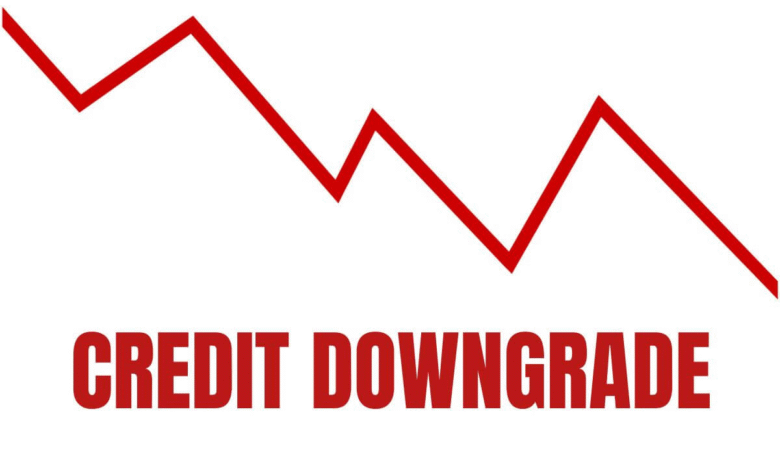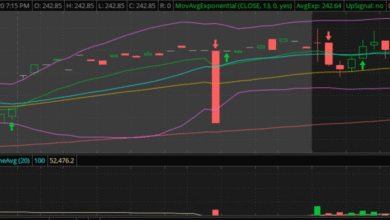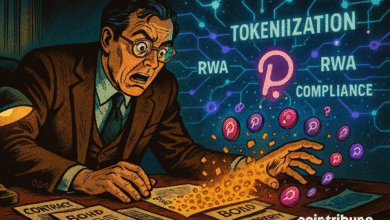US Credit Downgrade: Moody’s Warning on Debt and Economy

The recent US credit downgrade by Moody’s signals a serious turning point in the nation’s economic landscape, as the prestigious agency has lowered the nation’s credit rating from Aaa to Aa1. This downgrade arises amidst a backdrop of a looming US debt crisis, characterized by excessive deficits and insufficient fiscal tightening. Investors and economists alike are bracing for potential repercussions, particularly as recession fears escalate with increasing pressures on the economic outlook. The growing burden of national debt, coupled with an unpredictable bond market, intensifies concerns about the sustainability of US finances. As the Federal Reserve navigates these turbulent waters, understanding the implications of Moody’s downgrade is more critical than ever for stakeholders across various sectors.
The recent decision by Moody’s to lower the United States’ credit standing has sent shockwaves through financial markets, prompting heightened scrutiny of the nation’s fiscal health. This situation encapsulates broader concerns about rising US liability levels and the urgent need for strategic expenditure reforms. As the nation faces significant economic uncertainties, including intensified recession apprehensions, the ramifications of this downgrade reflect deep-rooted issues in public finance management. Financial analysts are now turning to alternative descriptors for the fiscal challenges, such as the ballooning federal deficit and shifting economic conditions that threaten to undermine investor confidence. In this climate, the implications of the downgrade extend beyond immediate market reactions, pointing to potential long-term consequences on America’s financial stability.
Understanding the Moody’s Downgrade of US Credit
On Friday, the significant decision by Moody’s to downgrade the U.S. long-term credit rating from Aaa to Aa1 has sent shockwaves throughout financial markets. This move is indicative of a larger trend that reflects the increasing risks associated with the mounting national debt. The downgrade highlights the urgent need for fiscal tightening measures, as the federal government grapples with persistent deficits while showing little indication of making the necessary adjustments in spending or taxation.
This shift comes at a critical time when the U.S. economy faces pressure from recession fears and rising interest rates. Investors and analysts are closely monitoring how the downgrade will impact the overall U.S. economic outlook, particularly concerning its status as a safe haven for global investors. As borrowing costs increase, the implications stretch beyond just fiscal policy; they could also amplify uncertainty in the bond markets, which are already experiencing turbulent conditions.
Fiscal Tightening: A Necessary Prescription?
In light of the downgrade, experts argue that significant fiscal tightening is essential if the U.S. intends to restore its fiscal health and stabilize its credit rating. This could involve a combination of increased taxation and aggressive cuts to spending, both of which are politically contentious yet necessary to mitigate the ever-growing debt burden. With the national debt projected to rise from 98% of GDP in 2024 to a staggering 134% by 2035, the need for a strategic and disciplined fiscal policy has never been more acute.
However, achieving effective fiscal tightening may prove challenging amid rising recession fears. The current economic environment, characterized by elevated inflation and slowing growth, poses a delicate balancing act for policymakers. Implementing austerity measures risks stifling economic activity further, potentially exacerbating the very recession concerns that the U.S. is currently grappling with. Thus, any fiscal strategy must be carefully calibrated to avoid deepening economic woes while addressing the overarching debt crisis.
Recession Fears: Navigating Economic Turbulence
As the U.S. faces increasing recession fears, the implications of Moody’s downgrade cannot be understated. Economic indicators suggest a waning growth trajectory, exacerbated by declining consumer spending and investment. Resilient sectors of the economy may be buckling under the weight of elevated borrowing costs, particularly as interest on federal loans is poised to consume a growing share of revenue. The risk of recession looms large, forcing policymakers to reconsider how best to stimulate growth without further inflating the national debt.
The interconnectedness of the global economy means that U.S. recession fears could have far-reaching consequences, influencing trade dynamics and investment flows. Investors are wary, and the turbulence in bond markets points to a loss of confidence that could trigger a downward spiral. Recession not only impacts domestic consumers and businesses but also undermines international economic partnerships and trade agreements, further complicating the U.S. fiscal landscape.
Exploring the US Economic Outlook Post-Downgrade
The U.S. economic outlook appears increasingly bleak in the wake of Moody’s downgrade. With a projected federal deficit of nearly 9% of GDP by 2035, the ability of the U.S. to service its debt is under severe scrutiny. While there are undeniably strengths in the U.S. economy, such as technological innovation and its status as the world’s primary reserve currency, these advantages may not sufficiently counterbalance the rapid deterioration of the country’s fiscal stability.
Market analysts are particularly concerned about how the downgrade could translate into higher borrowing costs for the government and consumers alike. With analysts predicting that interest on the debt could account for up to 30% of federal revenue by 2035, the fallout from elevated interest rates could eventually seep into every facet of the economy, from home purchases to business investments. Understanding these dynamics will be crucial for crafting responsive economic policy in this challenging landscape.
The Impact of Tariff Policies on US Creditworthiness
In an era marked by aggressive tariff policies, the creditworthiness of the United States is under intense scrutiny. The recent imposition of tariffs on trading partners has destabilized market confidence and incited volatility in both equity and bond markets. Such protective measures have raised the stakes for U.S. exporters and could potentially prompt retaliatory actions that strain international relationships, further complicating the already precarious fiscal situation.
As the costs of tariffs trickle down to consumers and businesses, the potential for economic contraction increases, which could deepen the already palpable recession fears. The tariffs, however well-intentioned for protecting domestic industries, pose new challenges for the U.S. economy’s long-term growth trajectory. Elevated prices and reduced trade could have far-reaching implications on the U.S. credit outlook as the ability to generate sustainable revenue becomes increasingly hampered by these external pressures.
Investor Sentiment Shifts Following US Credit Downgrade
The downgrade by Moody’s has prompted a noticeable shift in investor sentiment towards U.S. Treasury securities. Traditionally seen as a safe haven, the increasing perception of risk—combined with a potential downturn in economic growth—has made investors reassess their strategies. Concerns regarding escalating borrowing costs, coupled with the projected increase in federal debt, could lead to a decreased appetite for U.S. bonds, raising their yields and further complicating the overall financial landscape.
This change in sentiment highlights the critical need for the U.S. government to regain investor confidence through sound fiscal policy. Those backing U.S. government debt expect stability and reliable returns, but the recent indicators of a faltering economy, coupled with historical deficits, have created a more cautious investment environment. Should confidence continue to wane, the capabilities of the U.S. government to finance its operations without imposing further fiscal strains could be jeopardized.
The Deteriorating Fiscal Landscape of the US
The fiscal landscape of the U.S. is deteriorating at an alarming rate, with Moody’s downgrade shining a light on the insufficiencies in current policy responses to rising debt levels. While the government has shown a willingness to finance ongoing deficits through borrowing, the absence of significant reforms has left the economy vulnerable to both internal and external shocks. The increasing reliance on debt as a financing mechanism is particularly concerning given the projected growth in federal deficits and interest obligations.
As the debt-to-GDP ratio approaches critical levels, there is a growing consensus among economists and policymakers that immediate action is required to address the unsustainable trajectory. Without substantial reforms, the long-term viability of U.S. public finances may come into question. The situation is not just an economic issue; it poses significant risks to U.S. leadership on the global stage, compelling the administration to prioritize sustainable fiscal practices.
Long-term Implications of the US Credit Downgrade
The long-term implications following the U.S. credit downgrade by Moody’s could be profound, as the country’s economic policies come under increased scrutiny. Investors are likely to demand higher returns for the added risk associated with U.S. debt, which may in turn lead to increased costs for everyone from local governments to individual citizens seeking loans. If this trend escalates, the ramifications could extend far beyond immediate fiscal challenges, threatening the entire global economy that largely relies on U.S. currency stability.
Moreover, the resulting unease among consumers and businesses could further slow economic growth, hampering job creation and wage increases. The worries surrounding the U.S. economic outlook could become a self-fulfilling prophecy if confidence continues to erode. Thus, addressing these challenges with effective policy measures is critical not only for economic recovery but also for restoring faith in the creditworthiness of the United States as a reliable borrowing entity.
Mitigating Risks: Strategies for Recovery
To mitigate the risks stemming from Moody’s downgrade and the underlying fiscal challenges, policymakers must explore innovative strategies aimed at fostering economic recovery. One potential avenue is the implementation of prudent fiscal policies that prioritize deficit reduction while ensuring economic growth. Fostering partnerships between the public and private sectors could also play a vital role in stimulating investment, thus providing a boost to domestic industries.
Additionally, reforming taxation and spending policies could facilitate a more balanced approach to budgeting, ultimately leading to a sustainable path forward for the U.S. economy. Addressing these issues is more crucial than ever, as failure to do so may amplify the economic pressures already facing the nation. By taking decisive action now, the government can work toward restoring fiscal stability and rebuilding trust in U.S. financial practices.
Frequently Asked Questions
What does the recent US credit downgrade by Moody’s mean for the economy?
The recent downgrade of the US credit rating by Moody’s from Aaa to Aa1 signifies increased concerns regarding the country’s fiscal health and its ability to manage growing debt. This downgrade is likely to lead to higher borrowing costs and may reduce confidence in the US economic outlook, raising fears of a debt crisis.
How does Moody’s downgrade affect US debt and fiscal policy?
Moody’s downgrade highlights the escalating US debt burdens, which are expected to rise significantly in the coming years. With the federal debt projected to reach 134% of GDP by 2035, this situation underscores the urgent need for fiscal tightening through spending cuts or tax increases to manage and stabilize the debt.
What are the implications of the US credit downgrade for investors?
Investors may view the Moody’s downgrade as a signal to reassess their investments in US sovereign debt. Increased borrowing costs could attract less investor enthusiasm, leading to potential market volatility and impacting the overall stability of bond markets.
Why is there growing recession fear following the US credit downgrade?
The US credit downgrade by Moody’s comes amid rising recession fears due to increasing interest payments on national debt and chaotic market conditions. Concerns over the federal deficit expanding to nearly 9% of GDP further exacerbate these fears, indicating a dire trajectory for the US economy.
How does the US credit downgrade relate to fiscal tightening and recession fears?
The downgrade from Moody’s reflects the broader issues of fiscal tightening—or lack thereof—amid increasing recession fears. Without significant policy changes to reduce spending or increase revenue, the mounting US debt could lead to economic instability and a potential debt crisis.
What role do tariffs play in the US credit downgrade and economic outlook?
The implementation of aggressive tariffs has contributed to erratic market behavior and raised risks for the US economic outlook. These trade policies, combined with high borrowing costs, intensify uncertainty in financial markets and can lead to further credit downgrades if the fiscal situation does not improve.
How does the US downgrade impact the global perception of the US dollar?
Although the US dollar remains the world’s primary reserve currency, the Moody’s downgrade raises questions about the long-term viability of US public finances. As confidence in the fiscal health of the US government wanes, global perception of the dollar may be affected, potentially influencing its dominance as a reserve currency.
What are the long-term effects of the Moody’s downgrade on US fiscal health?
The long-term effects of Moody’s downgrade on US fiscal health could include increased borrowing costs, reduced investor confidence, and a greater burden of interest payments on future federal revenue. These factors may lead to a potential fiscal crisis if significant measures are not taken to address the growing debt and deficit.
| Key Points | Details |
|---|---|
| US Credit Rating Downgrade | Moody’s downgraded the US credit rating from Aaa to Aa1. |
| Reasons for Downgrade | Significant deficits, increasing debt, and lack of fiscal tightening measures. |
| Projected Federal Debt | Federal debt expected to rise from 98% of GDP in 2024 to 134% by 2035. |
| Deficit Projections | Federal deficit projected to rise to nearly 9% of GDP in 2035. |
| Interest Payments Impact | Interest on debt may account for 30% of federal revenue by 2035. |
| Economic Conditions | Rising recession concerns and erratic market behaviors affecting the economy. |
| Tariff Policies | President Trump imposed extensive tariffs affecting trade and market stability. |
| Strengths of US Economy | US economy has scale, technological innovation, and dollar’s reserve currency status. |
| Long-term Viability Issues | Moody’s warns of worsening fiscal standing compared to wealthy peers. |
Summary
The US credit downgrade represents a significant shift in the perception of America’s fiscal health and stability. Following Moody’s decision to lower the credit rating from Aaa to Aa1, concerns have escalated regarding the nation’s growing debt and long-term financial management. With projected federal debt surging and fiscal deficits widening, the downgrade highlights an urgent need for reevaluation of America’s economic policies. Observers are cautioned that failure to address these issues might prevent the US from regaining its financial foothold in an increasingly competitive global environment.



